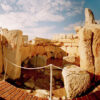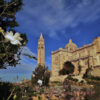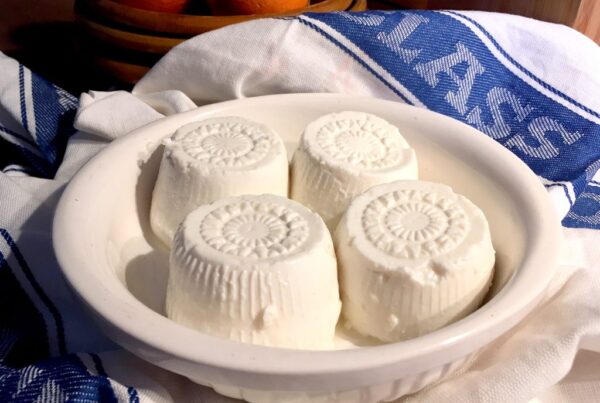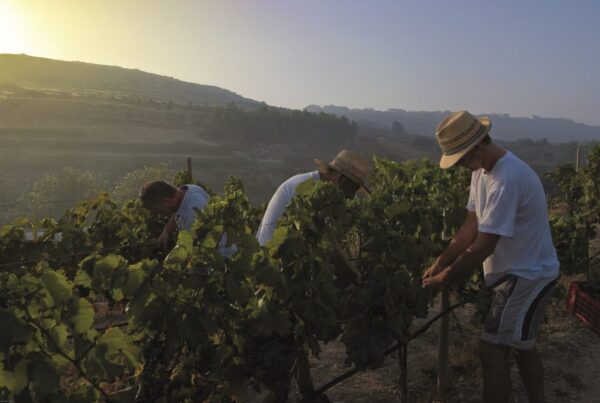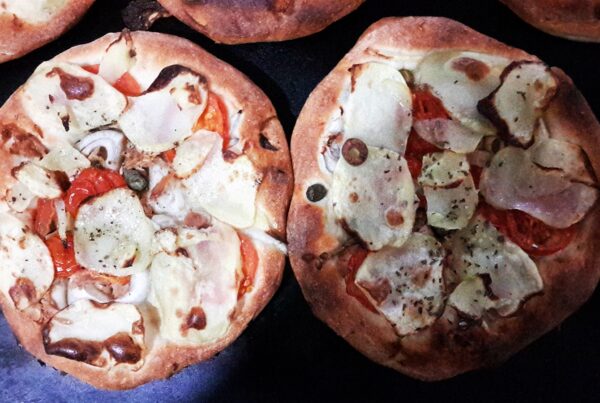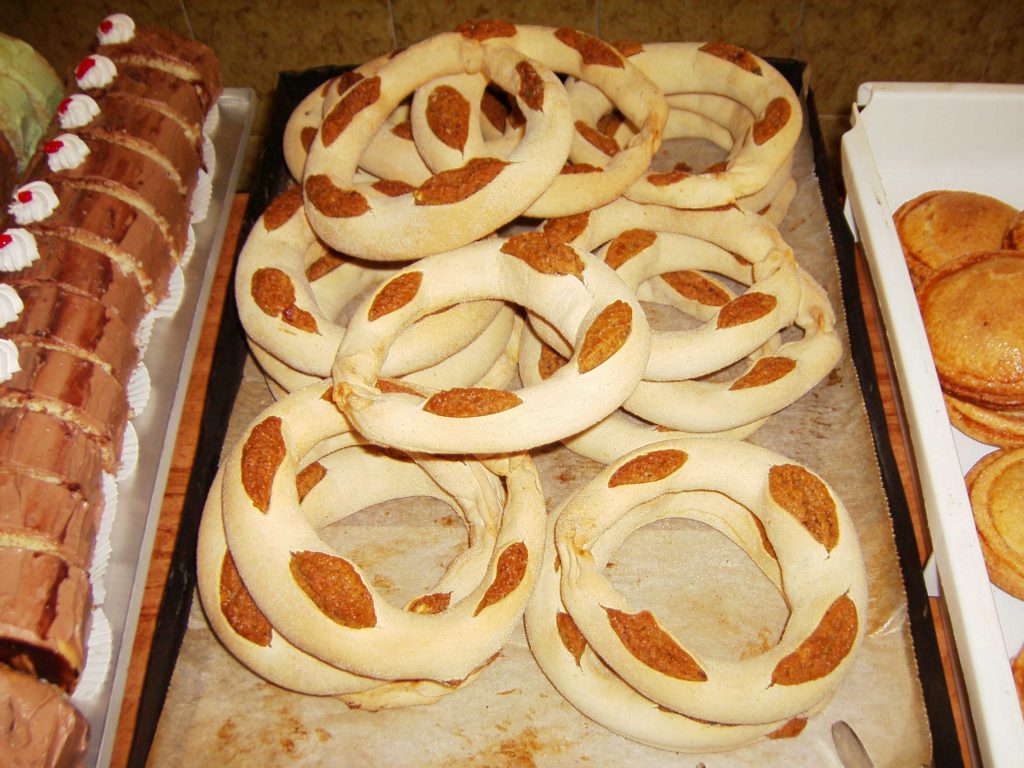
Although the Maltese on average seem to be hitting relatively high figures on the weighing scales compared to other countries within the EU, Maltese food itself is genuine and healthy, although it can be fairly calorie-dense, to put it mildly.
It’s the quantity of meals that are served at home and nowadays the readily available and relatively cheap fast food options that are causing most harm there. Savoury dishes make up for the largest part of Maltese cuisine, although the Maltese definitely know how to work with pastries and sweets.
Being a country surrounded by the sea, fish is traditionally the most popularly used protein, although beef and pork also feature in a few of the most popular traditional Maltese dishes.
Popular street food in Malta
- Maltese bread
If there’s one type of food that Maltese people abroad miss when they think of home, it’s Maltese bread. Traditionally baked Ħobż tal-Malti has a hard and crunchy crust on the outside and soft and fluffy white bread from the inside, and tastes nothing like a regular loaf of sliced white bread you might be used to from your local supermarket.
This big (or smaller – it comes in different sizes) round loaf of bread is usually bought whole or sliced and is sometimes the star carbohydrate of a dish and other times the mop that helps you get the last bits of that thick, delicious Maltese stew you just can’t get enough of. In fact, it’s served with most meals that allow for ‘mopping’ at the dinner table and is often served in local restaurants to accompany your meal as well.
Most Maltese people talk about the flavour of their bread, to me, as a semi-foreigner, it’s more the texture and the contrast between crunch and soft airy centre that made me fall in love with it.
The one downside is that it doesn’t last for very long. Buy a loaf on one day and it’ll taste stale the next day. That’s not necessarily an issue, though. You can find Maltese bread in every local “minimarket” (the logically smaller size of a supermarket, selling the everyday basics). Traditionally, the village of Qormi is known as the place where the best bakers fire up their ovens, but most local bakers (like Gormina (pron Jor-mina) in St. Paul’s Bay) will have delicious, freshly baked Maltese bread for sale in the morning. (They’ll be a-baking at 5am to serve the early risers). Local grocery shops receive a fresh supply daily, sometimes in the afternoon as well to serve those who like crispy fresh bread for supper.
Ħobż biż-żejt
Prepared for lunch and the most common way that Maltese bread is sold as street food is Ħobż biż-żejt (bread with oil, literally translated) specifically that’s the most popular way in which bread is consumed locally. Sliced Maltese bread with extra virgin olive oil, tomato paste and a pinch of salt and pepper, often dressed up with ingredients like tuna and capers, make for a very tasty snack, particularly so in summer.
The ftira
Ħobż tal-Malti isn’t the only type of Maltese bread that’s popularly served, though. The ftira is a flat baked, usually portion-sized bread (although bigger varieties are baked as well) that shares its crusty outside with a regular loaf of Maltese bread. It’s a popular option in lunchrooms and is prepared with a variety of local ingredients, often prepared to your tastes.
- Pastizzi and other savoury pastry snacks
Before McDonald’s, Burger King and KFC came around in Malta in the 1990s, fast food for the Maltese meant walking down to the nearest pastizzeria to grab some super tasty (but also amazingly greasy) savoury snacks, that form the cornerstone of street food in Malta.
The most popular snack are pastizzi – fluffy pastry formed in specific shapes and stuffed with either ricotta cheese or a paste of peas (piżelli in Maltese). You’ll also find the most oily square pizza slices (very tasty and fluffy nevertheless) and typically Maltese snacks like Qassatat (different type of pastry stuffed with cheese, peas and spinach), sausage rolls (you get to choose the cheese-filled type called Wudy, an Italian brand, for an extra dose of evil), Arancini (balls of tomato-flavoured rice with a breaded crust) and Timpana (a popular pasta oven dish).
Maltese bread is fluffy from the inside with a hard crust
Hobz biz-Zejt is a perfect snack based on Maltese bread
- Fish
Fish has always been popular in Malta, being an island where fish is relatively easy to come by in its surrounding waters.
You’ll be able to find all sorts of local fish served fresh daily in local restaurants, but there are specific types of fish that are traditionally more popular among the Maltese.
The first is Lampuka, (a species of dolphin fish also referred to as Mahi-mahi), which is caught seasonally and available as fresh catch during the period of 15th of August (the start date of Lampuki (plural) fishing season in Malta, also a public holiday) through to the end of December. You’ll still be able to taste Lampuka at other times of the year, but it obviously won’t be as fresh. Still worth your while though! Although available as a fried fish, it’s pretty popularly served in pie form as well (Torta tal-Lampuki).
Another type of fish to try is locally caught swordfish, prepared as a dish called Pixxispad (grilled swordfish steak). Fried in olive oil, lemon added – Super tasty. You’ll also find a few species of seabream, seabass and grouper, often cooked grilled on the skin or al cartoccio (Italian term that means something like baked in foil) with olive oil, lemon, salt/pepper seasoning and sometimes capers. They’ll often ask you which method you prefer, in fact.
- Rabbit
Although most people outside of Malta probably think of rabbits as “a nice pet for the kids”, in Malta rabbit is more commonly served as a dish, most popularly fried (sometimes with spaghetti with tomato sauce and peas) or as a stew (Stuffat Tal-Fenek). It’s important to note that I’ve never come across anyone in Malta who keeps rabbits as pets until Christmas comes around. Rabbits are bred OR kept as pets (and not consumed).
For most Europeans it’ll be a tough sell, but it really isn’t a big deal unless you’re vegan or vegetarian. It’s actually very tasty. Often likened to chicken by foreigner it’s a rich flavour and it’s understandable why it’s a popular choice among the locals. Dining is sometimes organised to be specifically for rabbit, called a fenkata. Two tips from this foreigner:
I might be the unluckiest consumer of rabbit on the island, but I regularly find small bone shards and have so far been lucky to escape without a trip to the dentist’s. Take small bites.
Some restaurants or bars in smaller villages that serve rabbit may serve the dish with kidneys and liver chunks included. If that’s a bridge too far for you as well, you can politely verify whether it’s served that way and asked not to be.
5. Kinnie
Kinnie is a soft drink produced only in Malta and it’s a bit like Marmite or Bovril if you’re British. Don’t worry, I’m not referring to the flavour, I’m referring to the fact that you either love Kinnie or you hate it.
Personally I really like it, particularly on a hot summer’s day. It’s a drink that has a bittersweet flavour that it owes to a particular type of bitter orange (referred to as Mediterranean chinotto) that you’re unlikely to have tasted before and is definitely worth trying. It’s also a great mixer to try with spirits like vodka and rum and usually tastes best cold.
If you want to go “pro”, there’s a variant called Kinnie Zest, which has a stronger, more pronounced flavour. Similar to the original, just stronger (and either better or worse depending on your personal taste).
- Ċisk
Ċisk (pron. Ch-isk) is the most popular (locally brewed) beer that’s an easy, light drink that’s generally liked by foreign beer lovers. Perhaps not the smoothest of beers, it has a gentle flavour and is very refreshing on a warm day.
Although many international brands are available on the island, most will opt to enjoy the local tipple. Aside from the original, low-carb (Cisk Excel), fruity flavoured (Chill Lemon and Chill Berry) and a few other variations are available. The same producers (Farsons) produce different ales as well.
Other traditional Maltese foods and dishes to try
In no particular order, here are a few other dishes that are worth trying if you happen to find them on a menu or you love cooking and decide to be adventurous.
- Maltese Olives
Olive groves speckle the countryside in Malta, bringing forth a huge quantity of the succulent orbs every year. They are often served up alongside bread before a meal or are used to make local, fresh olive oil which is a staple ingredient in Maltese cuisine.
- Capers
Like olives, capers are farmed in abundance throughout the hilly rural parts of Malta, offering a salty addition to a snack or a topping for crispy bruschetta. The best thing about the Maltese capers is their size – the ideal climate encourages them to grow to enormous sizes.
- Ġbejniet
Like in most Mediterranean cuisines, cheese is a star player of many dishes. Throughout the island there is an assortment of cheeses available, from mild hard cheeses to softer, stronger flavours. Ġbejniet is a popular choice – it’s a local sheep’s cheese that is often served up as part of a sharing platter.
- More exotic proteins
Apart from rabbit there are a few other proteins you may find on the menu at a few restaurants serving Maltese food.
I haven’t tried any of these myself, but perhaps you’re more adventurous than I am. Here goes:
Quail, a locally caught type of bird, is usually served fried with vegetables. It’s a small bird but apparently makes for a tasty meal. Snails, usually served in a bowl on their own, cooked with herbs and spices. Eaten with a toothpick. Horse meat, cooked in a stew to tenderize the otherwise quite tough meat.
- Aljotta
With easy access to a range of deliciously fresh seafood, fish features heavily in the Maltese cuisine and Aljotta is regional hearty fish stew, thickened out with garlic, tomatoes, and rice.
- Bragioli (beef olives)
The Maltese love their meat, and it features heavily in most dishes throughout the day. Bragioli is a popular beef dish with a difference. It boasts a mouth-watering concoction of bacon, egg, and garlic dipped in breadcrumbs and wrapped in tender slices of beef before being slow cooked in a rich sauce of wine.
- Maltese sausage
Traditional Maltese sausages (Zalzett Malti) pack a flavour punch of their own. Cooked together with aromatic coriander, they provide a little more depth than the average sausage.
Bragioli or beef olives is a popular Maltese dish
Maltese sausage as a main ingredient in a Maltese dish
Malta, Gozo and Valletta guidebooks by Malta Uncovered.
Need a Malta guidebook?
- Bigilla
Mezze platters are an important part of Maltese culture, just like many other Mediterranean cuisines, and Bigilla is a prominent character in these. Served alongside crusty bread and olive oil, this broad bean pate provides a tasty accompaniment to most dishes.
15. Oven Roast
For a wholesome, homely dish, tuck into a Bħal fil-Forn. It was traditionally a peasant’s dish many years ago because it combines such simple ingredients – either chicken, beef, or pork is cooked together with potatoes in an onion jus.
- Minestra (Minestrone soup)
Hearty soups characterise Maltese menus in the winter, and Minestra is one of the most common varieties. It’s a thick broth created with multiple fresh, seasonal vegetables, and is always served alongside thick slices of rustic bread and olive oil.
- Soppa tal-Armla (Widow’s soup)
Another typically Maltese soup, Soppa tal-Armla is a rich, tasty soup with potatoes, carrots, garlic, peas, cauliflower and ġbejniet (Maltese cheeselets) amongst other ingredients. Why is it called Widow’s soup? It refers to the simplicity of this soup, with ingredients even a poor widow could afford to buy.
- Broad bean and pasta soup
Making the most of Kusksu, tiny pasta shapes that are produced in Malta, Kusksu Bil-Ful combines flavourful broad beans with herbs and the omnipresent tomato paste that characterises so many of Malta’s dishes.
- Imqarrun il-Forn
This Italian-inspired pasta dish (Imqarrun il-Forn) makes use of macaroni, which is baked to perfection in a creamy, cheesy sauce. The top is often crisped up, providing a contrast between soft and crunchy textures – a delicious filling dish on every level.
- Spaghetti with sea urchins
The magnificent underwater world that surrounds Malta is home to some unusual creatures which often find themselves being served up at dinner time. Sea urchins are a national delicacy, commonly served up on a bed of spaghetti for a fusion of Italian and Maltese cuisine in a dish called Spaghetti Rizzi.
- Stuffed marrow
Marrow might be an unusual ingredient, but in Malta its rich flavours are brought out in this dish (Qarabaghli Mimli fil-Forn) where marrow rings are stuffed with tender mince beef and baked to delicious perfection.
- Spinach and tuna pie
The Maltese love their pies, particularly in the cooler months. Tuna and spinach are popular ingredients throughout Maltese cuisine, so it seems like a no-brainer that they’re paired together in this dish. Spinach and tuna pie combines the meaty flavours of tuna with spinach, onion, anchovies, olives, and garlic, which is then layered smoothly onto a moist pastry base.
- Stuffed Aubergines
The base ingredient for Brungiel Mimli are juicy aubergines which are then stuffed with tender beef or pork mince before being baked in the oven, resulting in a layered light bite with a crispy topping.













